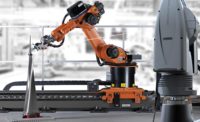From the Editor | Darryl Seland
The Singularity – The Promise of Technology?

Image Source: imaginima / E+ via Getty Images
I will admit it. The first time I saw the movie “The Terminator” it scared me senseless. I very much wanted to crawl under the bed and never come out. In my defense, I was only ten years old.
In the forty years since, I have engaged and appreciated this and countless other movies and stories that ask us to contemplate “the singularity.”
The singularity—or more accurately, the technological singularity—“is a hypothetical future point in time at which technological growth becomes uncontrollable and irreversible, resulting in unforeseeable consequences for human civilization.” The idea has been around since at least the middle of the last century, a response to what was seen as an acceleration of technological advances.
Since then, the debate about the singularity has centered around two points—does technology continue to accelerate and is the singularity ultimately a positive or a negative for the human race?
Roughly five years ago, in the article, “Despite What You Might Think, Major Technological Changes Are Coming More Slowly Than They Once Did” in Scientific American, author Wade Roush described the link between Man’s first powered flight and Man walking on the moon through one man’s lifespan: Charles Lindbergh visited the Wright Brothers after his historic cross-Atlantic flight and was present as a guest of Neil Armstrong at the launch of Apollo 11. In the same article, Roush discusses some of the examples of promised technologies that have not yet hit their mark (consumer robotics, self-driving cars) and quotes Northwestern University economist Robert Gordon and his argument that, other than computing power, nothing much has changed since 1970, saying, “The lives of people in developed nations look and feel the same in 2019 as they did in 1979 or 1989.”
RELATED ARTICLES
However, a case for acceleration can be made today, just five years later, with the “breakthrough” in artificial intelligence. What started with the introduction of ChatGPT and OpenAI has quickly progressed to discussions of how to use it, where to implement it, and yes, how to control it. I’m checking to see if it is clear under my bed.
Kidding aside, even though many scientists, including Stephen Hawking and the godfather of AI himself, Geoffrey Hinton, have expressed concerns about artificial intelligence, it is possible to focus on the positive, collaboration that does and can exist between humans and machines. As authors Elizabeth A. Cudney and Rebecca Ranzenbach write, “Machines can accomplish so much of what humans used to do. Now is the time to leverage technology while capitalizing on the unique qualities humans bring.”
So, check out Cudney and Ranzenbach’s article, “The Evolving Role of Quality Professionals in the Quality 4.0 Era: Merging Human Expertise with Technological Advancements,” and everything else we have to offer in this month’s Quality.
Enjoy and thanks for reading!
Looking for a reprint of this article?
From high-res PDFs to custom plaques, order your copy today!








